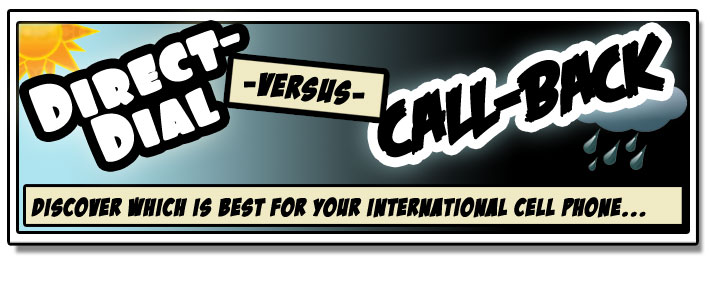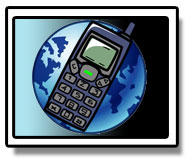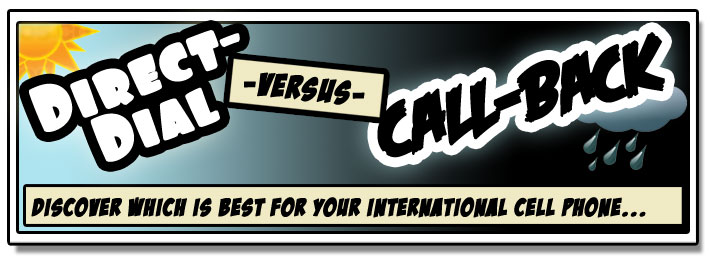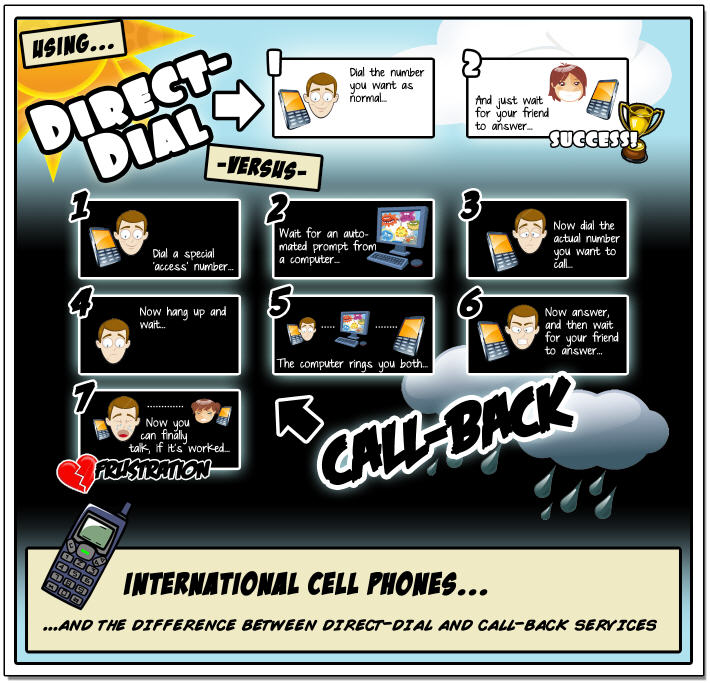
Travel overseas and want cheap international cell phone calls? New ‘call-back’ services claim to offer this, but before you jump in, discover how they compare overall to traditional direct-dial services…
If you find this post useful, please click on the buttons at the top, bottom or side of this page to like on Facebook or share on Twitter.
Introduction
If you travel overseas and have researched international cell-phones, you may have come across ‘direct-dial’ and ‘call-back’ as two different types of service you can choose between.
(Please note: call-back is also known as callback or switch.)
This is all good and well, but do you know exactly what they refer too, and more importantly, how to decide between them which is best for you?
In this article you will discover:
![]() What direct-dial and call-back services are
What direct-dial and call-back services are
What are direct-dial and call-back services?
 Direct-dial and call-back refer to two different technologies used to dial and connect telephone calls. Direct-dial is a system you are probably already familiar with, as it is used by most telephone services.
Direct-dial and call-back refer to two different technologies used to dial and connect telephone calls. Direct-dial is a system you are probably already familiar with, as it is used by most telephone services.
Basically, when you need to call someone you simply dial their number, wait a couple of seconds while you’re connected and start ringing them, and then just wait for them to answer.
Call-back on the other hand is more complicated because it involves an extra, third-party connection between you and the number you want to call. Here’s the two main ways call-back services work:
With some call-back services you must first dial an access number. Once you are connected you will hear a prompt to then dial the actual number you want. Then you will be instructed to hang up. You must then wait while the system rings both you and the number you want to dial. When your phone starts ringing, you answer it, and then wait for the person you’re calling to answer. Then you can finally talk.
Some call-back services have speeded up this process a little by removing the need for the access number. With these you can start by ringing the number you want to dial, like normal. Then your phone will automatically hang up and initiate the call back to both you and the number you’re calling.
See our infographic below for an illustrated version of the different dialing procedures…
Why was call-back developed?
 As you can see, using a call-back service adds a lot of extra steps and complications to the traditional direct-dial service, so why was it developed?
As you can see, using a call-back service adds a lot of extra steps and complications to the traditional direct-dial service, so why was it developed?
The answer is to try and help you save money when making calls internationally.
Using a direct-dial service international means that you can incur roaming charges on top of your normal call charges, to cover the cost of the international leg of your calls. For example, if you’re using an American phone number in France to call back home to America, you will have to pay for both the cost to connect from France to America, and then to connect the call within America.
Depending on which countries you’re calling from and too, these international sections can be expensive.
To try and get around these roaming charges, call-back services were developed. They do this by routing your call away from the more expensive cell phone network, and instead routing part of it over the Internet, which is a much cheaper option.
The advantages and disadvantages of each service
 As mentioned above, call-back services were developed to try and reduce the costs for you to use your cell phone overseas, which can be seen as a big advantage, but it is not always so cut and dried as this.
As mentioned above, call-back services were developed to try and reduce the costs for you to use your cell phone overseas, which can be seen as a big advantage, but it is not always so cut and dried as this.
As with most things in life, you need to choose between cheaper or better, and this is certainly true when comparing these two types of services.
Below are the extra things you need to take into account when choosing between direct-dial and call-back services.
The advantages of direct-dial:
![]() Convenience: The first advantage of direct-dial is that it is easy to make your calls. You simply dial the number you want, get connected and then wait for the other person to answer. No waiting around and no following different steps.
Convenience: The first advantage of direct-dial is that it is easy to make your calls. You simply dial the number you want, get connected and then wait for the other person to answer. No waiting around and no following different steps.
![]() Speed: The second advantage of direct-dial is the speed at which you are connected. Obviously the time it takes to dial is quicker, as there are less steps, but also on average the time it takes to connect your two phones together is also quicker. With call-back and re-routing over the Internet, the connection time, depending on which country you’re calling from, can be very long.
Speed: The second advantage of direct-dial is the speed at which you are connected. Obviously the time it takes to dial is quicker, as there are less steps, but also on average the time it takes to connect your two phones together is also quicker. With call-back and re-routing over the Internet, the connection time, depending on which country you’re calling from, can be very long.
![]() Quality and success: Lastly, and most importantly, with direct-dial you get a better quality of call, and you’re more likely to successfully connect to the number you want to call.This is because with direct-dial there’s only one connection between you and the other person, and everything is handled over the cell phone network, so there is little to go wrong. With call-back, adding in the extra, less stable step of routing your call over the Internet can severely reduce the quality of your call, and often not even be able to successfully connect your call.
Quality and success: Lastly, and most importantly, with direct-dial you get a better quality of call, and you’re more likely to successfully connect to the number you want to call.This is because with direct-dial there’s only one connection between you and the other person, and everything is handled over the cell phone network, so there is little to go wrong. With call-back, adding in the extra, less stable step of routing your call over the Internet can severely reduce the quality of your call, and often not even be able to successfully connect your call.
When you’re overseas and reliant on your cell phone, being able to successfully place your call is often far more important than saving a few extra cents on the price.
The disadvantages of direct-dial
![]() Comparative cost: As has been mentioned, direct-dial systems usually incur roaming fees added to your call costs to cover the international legs to route your call from whichever country you are in to whichever country you are calling. This is unavoidable but ensures you get the quickest, easiest and best quality calls possible where you are.
Comparative cost: As has been mentioned, direct-dial systems usually incur roaming fees added to your call costs to cover the international legs to route your call from whichever country you are in to whichever country you are calling. This is unavoidable but ensures you get the quickest, easiest and best quality calls possible where you are.
The advantages of call-back
![]() Cheaper: The whole purpose of the development of call-back services was to try and cut the costs of using your international cell phone overseas, compared to the traditional direct-dial services. This has been done by re-routing the calls over the Internet, however, it’s been at the expense of the ease and quality of your calls.
Cheaper: The whole purpose of the development of call-back services was to try and cut the costs of using your international cell phone overseas, compared to the traditional direct-dial services. This has been done by re-routing the calls over the Internet, however, it’s been at the expense of the ease and quality of your calls.
The disadvantages of call-back
![]() Long-winded: Due to the way that call-back services work, they’ve had to complicate the standard dialing procedure, making it much more long-winded to place a quick call.
Long-winded: Due to the way that call-back services work, they’ve had to complicate the standard dialing procedure, making it much more long-winded to place a quick call.
![]() Slow: Not only has the number of steps to dial a number increased, but also the length of time you must wait for your call to connect (assuming it is successful) is also increased as the third-party Internet connection does not always work as well as the standard cell phone network connection.
Slow: Not only has the number of steps to dial a number increased, but also the length of time you must wait for your call to connect (assuming it is successful) is also increased as the third-party Internet connection does not always work as well as the standard cell phone network connection.
![]() Unreliable: By using an extra third-party Internet connection, the quality of calls placed using call-back services can be affected, or even fail to connect in the first place.
Unreliable: By using an extra third-party Internet connection, the quality of calls placed using call-back services can be affected, or even fail to connect in the first place.
This can be due to the fact that there are more things to go wrong when you start adding extra steps, but also to the fact that the Internet connection is just not as robust or reliable as the cell phone network connection.
![]() Low security: Because your calls are rerouted over the Internet, it has been suggested that the security of your calls is much lower than if you were using a standard direct-dial service.
Low security: Because your calls are rerouted over the Internet, it has been suggested that the security of your calls is much lower than if you were using a standard direct-dial service.
![]() Legal status: In some countries call-back services have been banned or blocked from working. This is because they cannot be licensed or regulated by the local governments.
Legal status: In some countries call-back services have been banned or blocked from working. This is because they cannot be licensed or regulated by the local governments.
Some have argued that it is really because many telephone networks are state owned, and so the governments are worried they’re losing revenue, but either way to could limit where you can use your call-back service.
Call-back not always advertized up-front
 It is important to note that many companies who provide call-back services do not specifically advertize them as being call-back up front. You only find out once you receive your service and see the dialing instructions.
It is important to note that many companies who provide call-back services do not specifically advertize them as being call-back up front. You only find out once you receive your service and see the dialing instructions.
This is often done as the companies selling them fear you would be put off the service, as it is not something you’re used to, or you would see as being overly complicated.
If you are concerned whether you are buying a call-back service or not, always ask the company first.
Which service is best for you?
When it comes to choosing between direct-dial and call-back it really comes down to one main choice when you’re traveling.
Think about why you’re taking an international cell phone, what types of calls you intend to make, and how many calls you intend to make, then choose between:
![]() Choose call-back if you’re desperate to save as much as you can at the expense of the reliability of the service, or the calls you intend to make are not so important
Choose call-back if you’re desperate to save as much as you can at the expense of the reliability of the service, or the calls you intend to make are not so important
![]() Choose direct-dial if you want peace-of-mind that you’ll be able to place important calls when you need to when overseas
Choose direct-dial if you want peace-of-mind that you’ll be able to place important calls when you need to when overseas
For the record, Mobal’s international cell phone services us a direct-dial service.

If you find this post useful, please click on the buttons at the top, bottom or side of this page to like on Facebook or share on Twitter.

